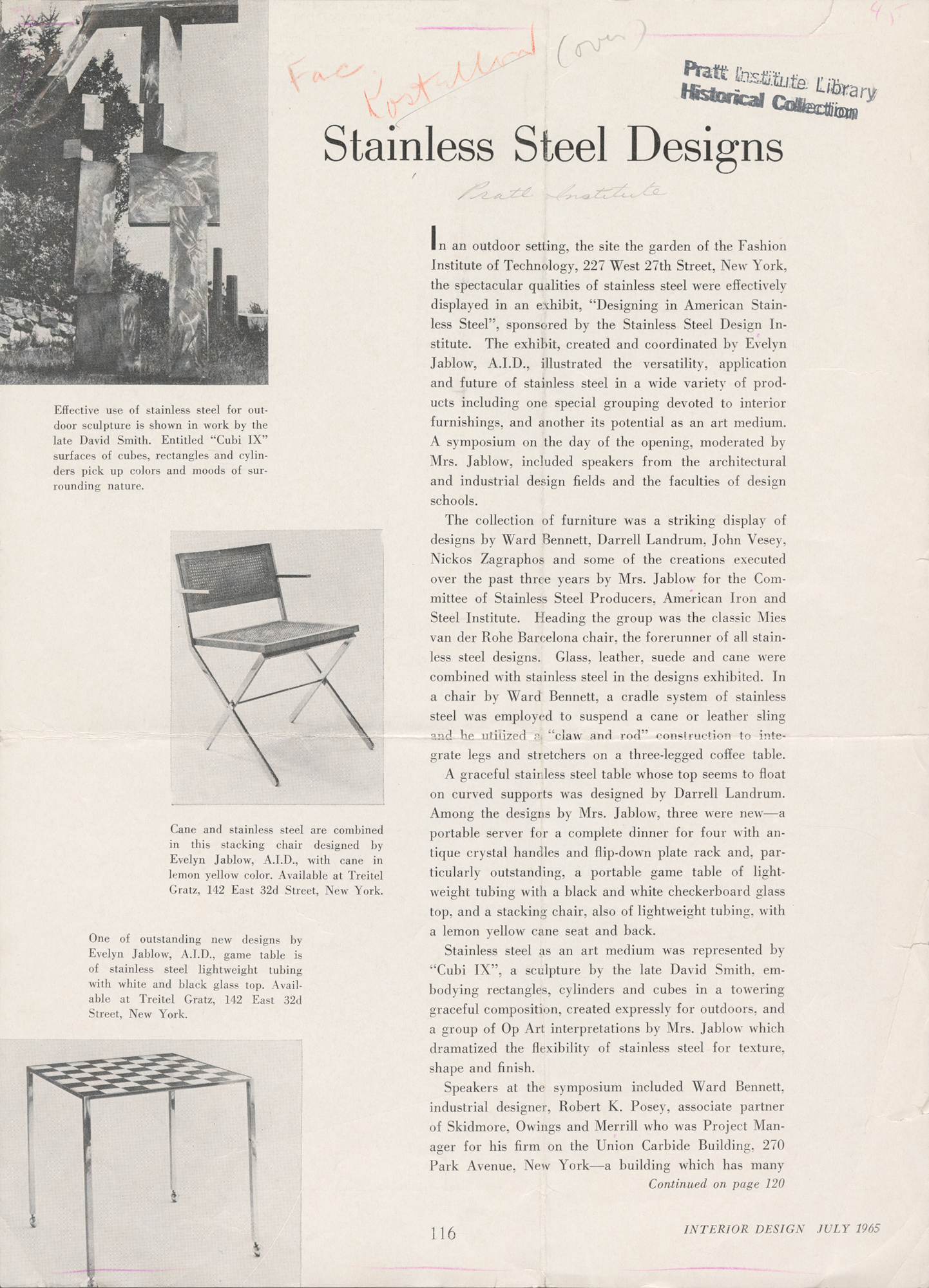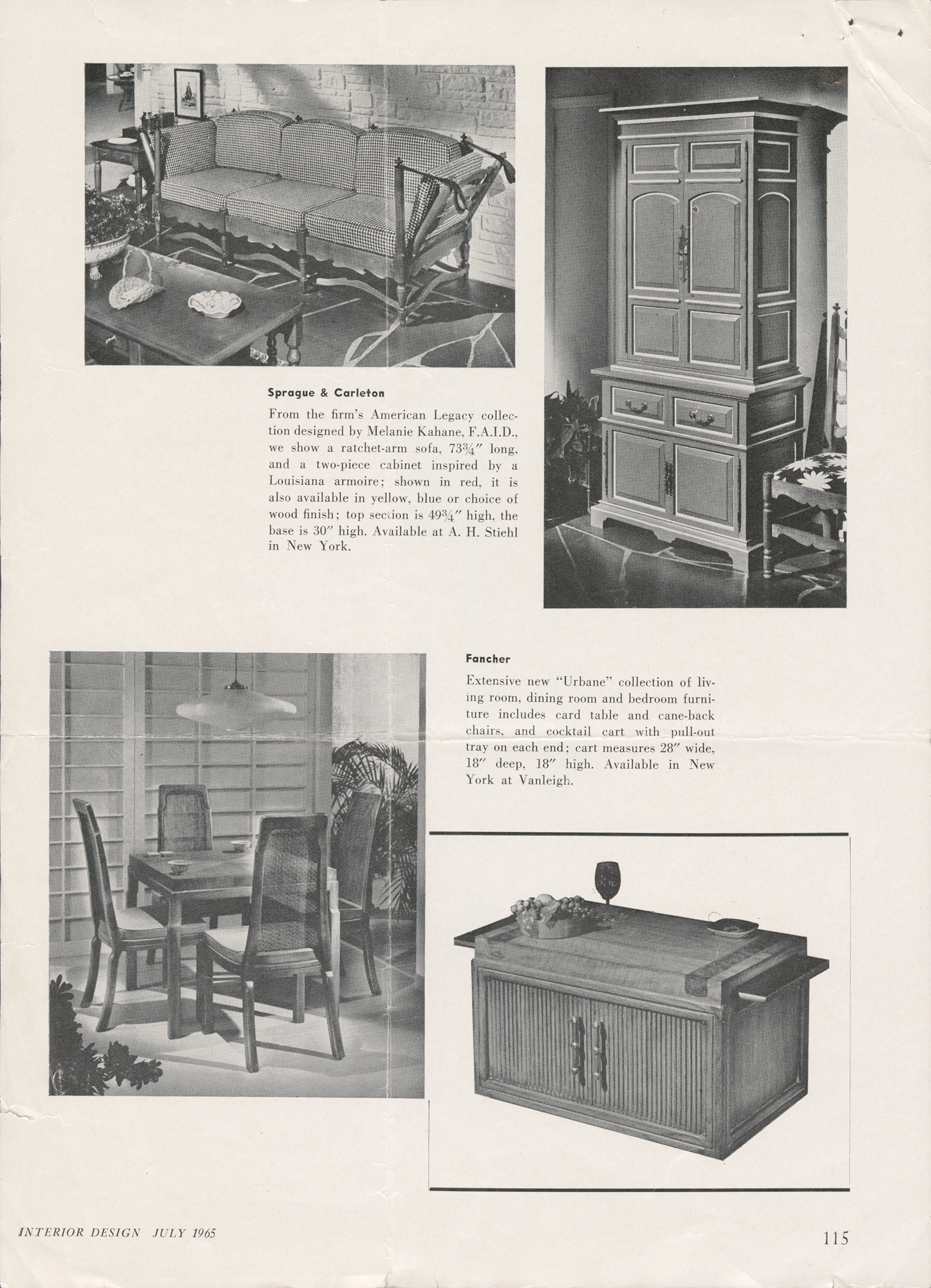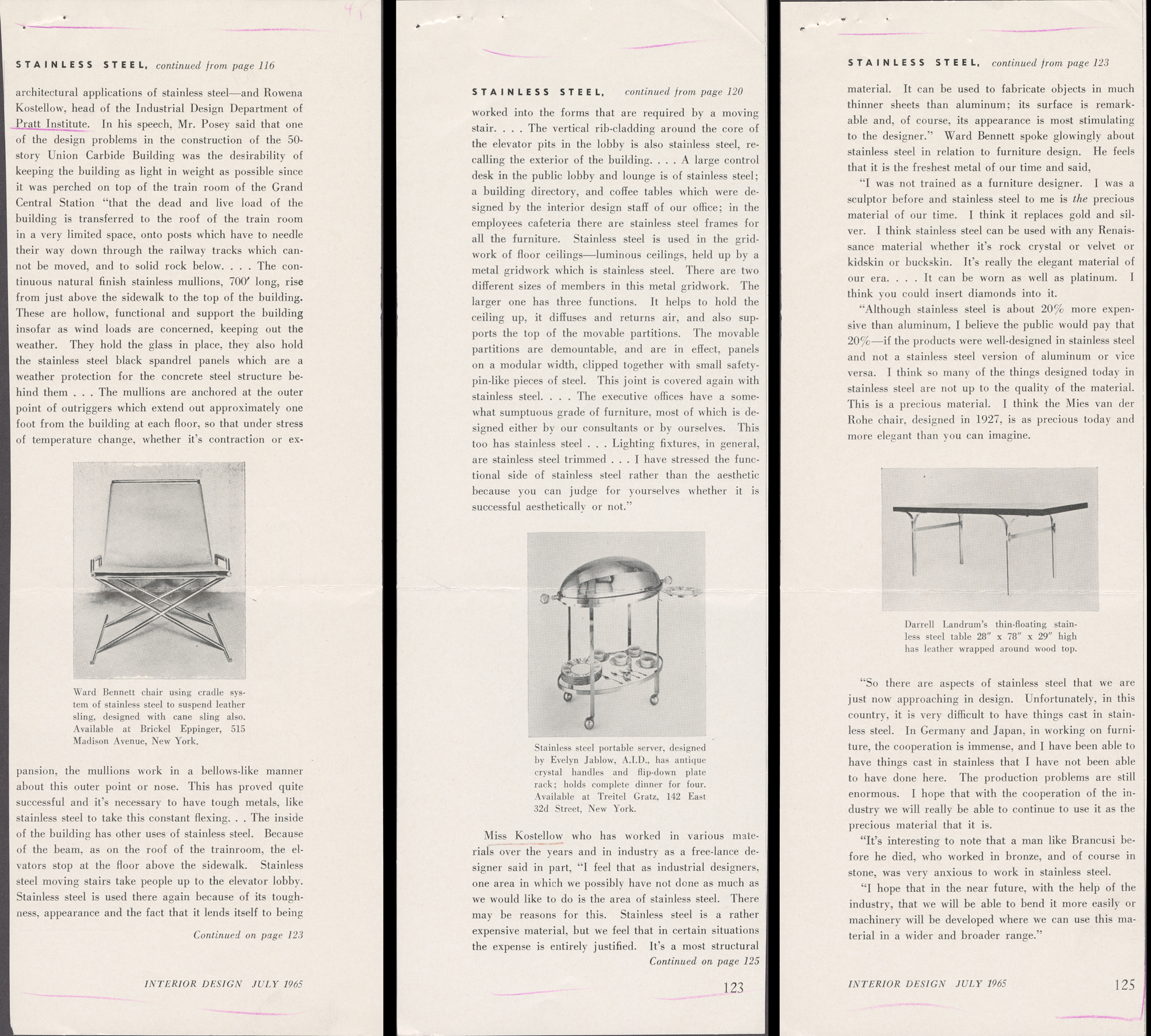Stainless Steel Design



Interior Design, 1965
In an outdoor setting, the site the garden of the Fashion Institute of Technology, 227 West 27th Street, New York, the spectacular qualities of stainless steel were effectively displayed in an exhibit, “Designing in American Stainless Steel”, sponsored by the Stainless Steel Design In-stitute.
The exhibit, created and coordinated by Evelyn Jablow, A.I.D., illustrated the versatility, application and future of stainless steel in a wide variety of products including one special grouping devoted to interior furnishings, and another its potential as an art medium.
A symposium on the day of the opening, moderated by Mrs. Jablow, included speakers from the architectural and industrial design fields and the faculties of design schools.
The collection of furniture was a striking display of designs by Ward Bennett, Darrell Landrum, John Vesey, Nickos Zagraphos and some of the creations executed over the past three years by Mrs. Jablow for the Committee of Stainless Steel Producers, American Iron and Steel Institute. Heading the group was the classic Mies van der Rohe Barcelona chair, the forerunner of all stainless steel designs. Glass, leather, suede and cane were combined with stainless steel in the designs exhibited. In a chair by Ward Bennett, a cradle system of stainless steel was employed to suspend a cane or leather sling and he utilized a “claw and rod” construction to integrate legs and stretchers on a three-legged coffee table.
A graceful stair less steel table whose top seems to float on curved supports was designed by Darrell Landrum.
Among the designs by Mrs. Jablow, three were new—a portable server for a complete dinner for four with antique crystal handles and flip-down plate rack and, particularly outstanding, a portable game table of lightweight tubing with a black and white checkerboard glass top, and a stacking chair, also of lightweight tubing, with a lemon yellow cane seat and back.
Stainless steel as an art medium was represented by “Cubi IX”, a sculpture by the late David Smith, embodying rectangles, cylinders and cubes in a towering graceful composition, created expressly for outdoors, and a group of Op Art interpretations by Mrs. Jablow which dramatized the flexibility of stainless steel for texture, shape and finish.
Speakers at the symposium included Ward Bennett, industrial designer, Robert K. Posey, associate partner of Skidmore, Owings and Merrill who was Project Manager for his firm on the Union Carbide Building, 270 Park Avenue, New York—a building which has many
Continued on page 120
Sprague & Carleton
From the firm’s American Legacy collection designed by Melanie Kahane, F.A.I.D., we show a ratchet-arm sofa, 73¾” long, and a two-piece cabinet inspired by a Louisiana armoire; shown in red, it is also available in yellow, blue or choice of wood finish; top section is 49¾” high, the base is 30″ high. Available at A. H. Stiehl in New York.
Extensive new “Urbane” collection of living room, dining room and bedroom furniture includes card table and cane-back chairs, and cocktail cart with pull-out tray on each end; cart measures 28″ wide, 18″ deep, 18″ high. Available in New York at Vanleigh
architectural applications of stainless steel and Rowena Kostellow, head of the Industrial Design Department of Pratt Institute. In his speech, Mr. Posey said that one of the design problems in the construction of the 50-story Union Carbide Building was the desirability of keeping the building as light in weight as possible since it was perched on top of the train room of the Grand Central Station “that the dead and live load of the building is transferred to the roof of the train room in a very limited space, onto posts which have to needle their way down through the railway tracks which cannot be moved, and to solid rock below. … The continuous natural finish stainless mullions, 700′ long, rise from just above the sidewalk to the top of the building.
These are hollow, functional and support the building insofar as wind loads are concerned, keeping out the weather. They hold the glass in place, they also hold the stainless steel black spandrel panels which are a weather protection for the concrete steel structure behind them… The mullions are anchored at the outer point of outriggers which extend out approximately one foot from the building at each floor, so that under stress of temperature change, whether it’s contraction or ex-
Ward Bennett chair using cradle system of stainless steel to suspend leather sling, designed with cane sling also.
Available at Brickel Eppinger, 515 Madison Avenue, New York.
the mullions work in a bellows-like manner about this outer point or nose. This has proved quite successful and it’s necessary to have tough metals, like stainless steel to take this constant flexing. .. The inside of the building has other uses of stainless steel. Because of the beam, as on the roof of the trainroom, the el-vators stop at the floor above the sidewalk. Stainless steel moving stairs take people up to the elevator lobby.
Stainless steel is used there again because of its tough-ness, appearance and the fact that it lends itself to being
Continued on page 123
INTERIOR DESIGN JULY 1965
STAINLESS STEEL,
continued from page 120
worked into the forms that are required by a moving stair. … The vertical rib-cladding around the core of the elevator pits in the lobby is also stainless steel, recalling the exterior of the building. … A large control desk in the public lobby and lounge is of stainless steel; a building directory, and coffee tables which were designed by the interior design staff of our office; in the employees cafeteria there are stainless steel frames for all the furniture. Stainless steel is used in the grid-work of floor ceilings–luminous ceilings, held up by a metal gridwork which is stainless steel.
There are two different sizes of members in this metal gridwork. The larger one has three functions. It helps to hold the ceiling up, it diffuses and returns air, and also supports the top of the movable partitions.
The movable partitions are demountable, and are in effect, panels on a modular width, clipped together with small safety-pin-like pieces of steel. This joint is covered again with stainless steel. … The executive offices have a somewhat sumptuous grade of furniture, most of which is designed either by our consultants or by ourselves. This too has stainless steel … Lighting fixtures, in general, are stainless steel trimmed … I have stressed the functional side of stainless steel rather than the aesthetic because you can judge for yourselves whether it is successful aesthetically or not.”
Stainless steel portable server, designed by Evelyn Jablow, A.I.D., has antique crystal handles and flip-down plate rack; holds complete dinner for four.
Available at Treitel Gratz, 142 East 32d Street, New York.
Miss Kostellow who has worked in various materials over the years and in industry as a free-lance designer said in part, “I feel that as industrial designers, one area in which we possibly have not done as much as we would like to do is the area of stainless steel.
There may be reasons for this. Stainless steel is a rather expensive material, but we feel that in certain situations the expense is entirely justified. It’s a most structural its surface is remarkable and, of course, its appearance is most stimulating to the designer.” Ward Bennett spoke glowingly about stainless steel in relation to furniture design.
He feels that it is the freshest metal of our time and said, “I was not trained as a furniture designer. I was a sculptor before and stainless steel to me is the precious material of our time. I think it replaces gold and silver. I think stainless steel can be used with any Renaissance material whether it’s rock crystal or velvet or kidskin or buckskin. It’s really the elegant material of our era…. It can be worn as well as platinum. think you could insert diamonds into it.
“Although stainless steel is about 20% more expensive than aluminum, I believe the public would pay that 20%—if the products were well-designed in stainless steel and not a stainless steel version of aluminum or vice versa. I think so many of the things designed today in stainless steel are not up to the quality of the material.
This is a precious material. I think the Mies van der Rohe chair, designed in 1927, is as precious today and more elegant than you can imagine. Darrell Landrum’s thin-floating stainless steel table 28″x 78″ x 29″ high has leather wrapped around wood top.
“So there are aspects of stainless steel that we are just now approaching in design. Unfortunately, in this country, it is very difficult to have things cast in stainless steel. In Germany and Japan, in working on furni-ture, the cooperation is immense, and I have been able to have things cast in stainless that I have not been able to have done here. The production problems are still enormous. I hope that with the cooperation of the industry we will really be able to continue to use it as the precious material that it is.
“It’s interesting to note that a man like Brancusi before he died, who worked in bronze, and of course in stone, was very anxious to work in stainless steel.
“I hope that in the near future, with the help of the industry, that we will be able to bend it more easily or machinery will be developed where we can use this material in a wider and broader range.”
INTERIOR DESIGN JULY 1965
125